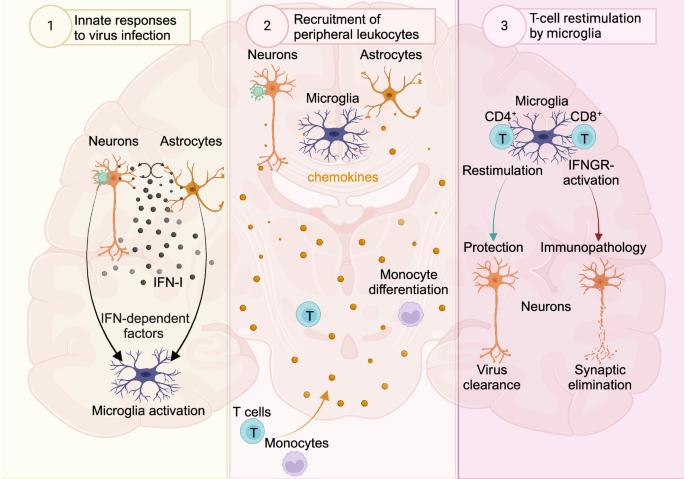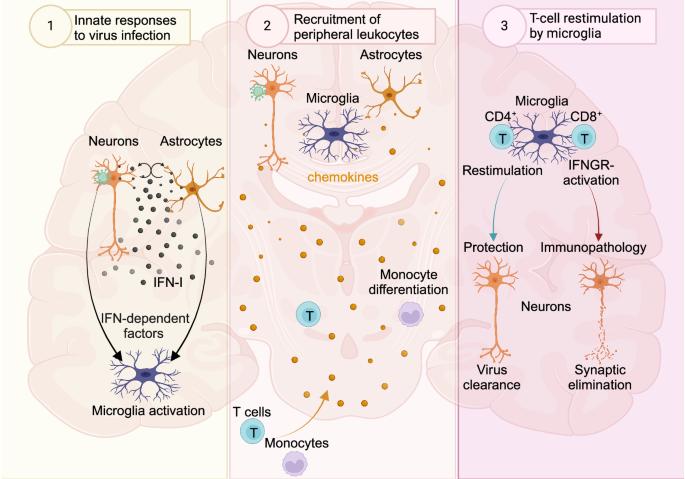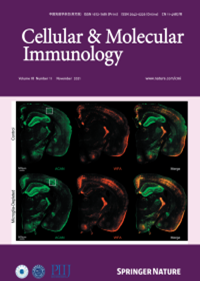Orchestration of antiviral responses within the infected central nervous system
IF 21.8
1区 医学
Q1 IMMUNOLOGY
引用次数: 0
Abstract
Many newly emerging and re-emerging viruses have neuroinvasive potential, underscoring viral encephalitis as a global research priority. Upon entry of the virus into the CNS, severe neurological life-threatening conditions may manifest that are associated with high morbidity and mortality. The currently available therapeutic arsenal against viral encephalitis is rather limited, emphasizing the need to better understand the conditions of local antiviral immunity within the infected CNS. In this review, we discuss new insights into the pathophysiology of viral encephalitis, with a focus on myeloid cells and CD8+ T cells, which critically contribute to protection against viral CNS infection. By illuminating the prerequisites of myeloid and T cell activation, discussing new discoveries regarding their transcriptional signatures, and dissecting the mechanisms of their recruitment to sites of viral replication within the CNS, we aim to further delineate the complexity of antiviral responses within the infected CNS. Moreover, we summarize the current knowledge in the field of virus infection and neurodegeneration and discuss the potential links of some neurotropic viruses with certain pathological hallmarks observed in neurodegeneration.


在受感染的中枢神经系统内协调抗病毒反应。
许多新出现和再次出现的病毒都有可能侵入神经系统,因此病毒性脑炎成为全球研究的重点。病毒进入中枢神经系统后,可能会出现严重的神经系统症状,危及生命,发病率和死亡率都很高。目前针对病毒性脑炎的治疗手段非常有限,因此需要更好地了解受感染的中枢神经系统内局部抗病毒免疫的条件。在这篇综述中,我们讨论了对病毒性脑炎病理生理学的新认识,重点是骨髓细胞和 CD8+ T 细胞,它们对保护中枢神经系统免受病毒感染起着至关重要的作用。通过阐明髓系细胞和 T 细胞活化的先决条件、讨论有关其转录特征的新发现以及剖析它们被招募到中枢神经系统内病毒复制位点的机制,我们旨在进一步阐明受感染的中枢神经系统内抗病毒反应的复杂性。此外,我们还总结了病毒感染和神经变性领域的现有知识,并讨论了一些神经滋养病毒与神经变性中观察到的某些病理特征之间的潜在联系。
本文章由计算机程序翻译,如有差异,请以英文原文为准。
求助全文
约1分钟内获得全文
求助全文
来源期刊
CiteScore
31.20
自引率
1.20%
发文量
903
审稿时长
1 months
期刊介绍:
Cellular & Molecular Immunology, a monthly journal from the Chinese Society of Immunology and the University of Science and Technology of China, serves as a comprehensive platform covering both basic immunology research and clinical applications. The journal publishes a variety of article types, including Articles, Review Articles, Mini Reviews, and Short Communications, focusing on diverse aspects of cellular and molecular immunology.

 求助内容:
求助内容: 应助结果提醒方式:
应助结果提醒方式:


